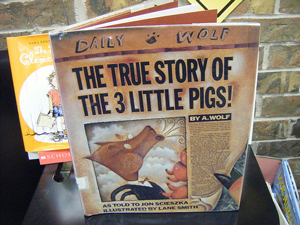
Source: The True Story of the 3 Little Pigs, Schu, Flickr
Remember the children’s story of “The Three Little Pigs”? Chances are you do. It’s a wonderful tale about the importance of hard work and cleverness that is traditionally told by a third-person narrator (more about this later in the lesson). It usually begins something like this:
Once upon a time, there was a mother pig with three little pigs. One day, she realized that she didn’t have enough food to feed them, so she decided to send them out to seek their own fortune.
Because this lesson is on point of view in literature, try pretending that this same story is told from the perspective of not the three pigs, but the big bad wolf. Click on the link to watch a video that might just change the way you think about this childhood favorite.
Source: The TRUE story of the 3 little pigs by A.Wolf as told to Jon Scieszka, Grandma Annii, YouTube
It’s pretty clear that this well-known story is changed completely just by a switch in perspective or viewpoint. Whereas the original story is usually told from a third-person point of view, the video uses a first-person narrator, the wolf who only wanted to get a cup of sugar for his poor sweet grandma’s birthday cake! It just goes to show you how important point of view is to literature.

Source: My Dusty Helios's Point of View, Ash If, Flickr
Keep in mind that an author tells a story, any story—whether in the form of a graphic novel, film, poem, or comic book—from a certain point of view for specific reasons. As you’ve just seen, sometimes an author’s choice can have quite an impact on how you as a reader understand the story and its characters, conflicts, and resolutions.
In the example of “The True Story of the Three Little Pigs,” you saw how the meaning of the story was dramatically changed simply by switching narrators from someone outside of the story—a third-person narrator—to someone inside the story—the wolf, who is a first-person narrator.
 Later in the lesson, you’ll see how this change in perspective alters other aspects of the writing, but for now, why don’t you try your hand at making your own dramatic change by writing an alternate passage to the one below? To do this, rewrite the story from the perspective of one of the characters in the story (first-person) instead of someone outside of the action (third-person). HINT: Replace either the she/her or he/him pronouns with I, me, and my. Use your notes to write your passage. When you are finished, check your understanding to see a sample response.
Later in the lesson, you’ll see how this change in perspective alters other aspects of the writing, but for now, why don’t you try your hand at making your own dramatic change by writing an alternate passage to the one below? To do this, rewrite the story from the perspective of one of the characters in the story (first-person) instead of someone outside of the action (third-person). HINT: Replace either the she/her or he/him pronouns with I, me, and my. Use your notes to write your passage. When you are finished, check your understanding to see a sample response. One day, Little Red Riding Hood wanted to visit her granny in the forest. She filled a basket of goodies and set out on the journey through the woods. Not far down the path, she caught her foot on a vine and tumbled to the ground, twisting her ankle badly. Unable to walk, she sat and began to cry. Just then a wolf came along and asked if he could help her. She accepted his offer to help but worried that her grandmother would be afraid of him when she saw he was a wolf, so she gave him her red riding hood. “Surely,” she thought, “my dear old granny would recognize it and not be frightened.” The wolf thanked her and promised to deliver the goodies right away.
I wanted to visit my granny in the forest, so I filled a basket with goodies and set out on the journey through the woods. Not far down the path, I caught my foot on a vine and tumbled to the ground, twisting my ankle badly. Unable to walk, I sat down and began to cry. Just then a wolf came along and asked if he could help me. I accepted his offer to help but worried that my grandmother would be afraid of him when she saw he was a wolf, so I gave him my red riding hood. Surely, I thought, my dear old granny would recognize it and not be frightened. The wolf thanked me and promised to deliver the goodies right away.